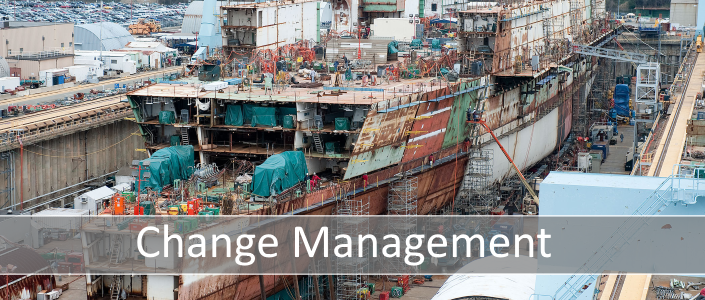
Shipbuilding is one of the most difficult manufacturing industries. There are many reasons for this but the key reason is that in shipbuilding you design, engineer, construct and procure materials all at the exact same time. This complicates almost every aspect of the process. People are always surprised that the first piece of steel is cut when less than 50% of the ship is fully designed. Also, the sheer number of parts of a ship (x10 more than aerospace) does not simplify our challenge.
Because engineering is happening at the same time as many other activities that are required to build a ship, change management is not just important; it is essential! There are several key aspects of change management such as identifying the change, determining the additional cost of different solutions, assigning and scheduling the change, communicating the change to stakeholders, and managing the changes across sister ships which are at different stages of design and construction.
Many departments and processes are affected by changes, e.g., detail planning, capacity planning, purchasing, operations, the shop floor, resource management, testing engineers, weight management, quality control and many, many others. It is important to synchronize the result of your changes to all the diverse people in your organization in a way they can consume and make decisions.
In this blog series, I will focus on how SSI users identify what was actually changed in the product data model as well as how they are communicating the change to the many stakeholders.
ShipConstructor Task Management
When any user connects to ShipConstructor they are accomplishing a specific task. This task is defined by management with influence from other departments such as capacity planning which determines the block/unit sequence. From a change management perspective, the ShipConstructor Task can represent an engineering required action (model bilge system in Unit 1234), Engineering Change Order (ECO), Engineering Change Notice (ECN) or whatever the comparable variation the shipyard names it.
The first step is to capture these tasks in ShipConstructor Task Management window. This will represent your master task list for all the actions you require your team to implement in ShipConstructor. This can have a one-to-one relationship with the ECO/ECN or, in some cases, for large changes you may create multiple subtasks to complete the entire change request.
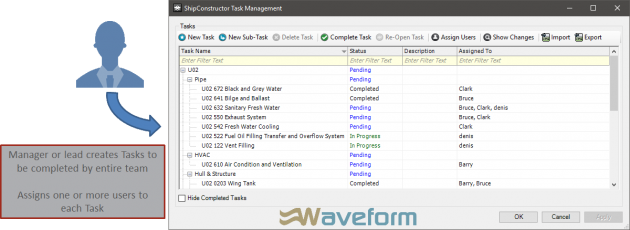
Note: This list can be automated if you are using an external system such as PLM which will be discussed in a future blog post in the series.
Each task can be assigned to one or more team members depending on your company’s policies and processes. ShipConstructor Task Management is designed to allow you to enter your tasks and sub-tasks very quickly with very little overhead. It also allows you to create specific views of the data in order to customize the view depending on your needs.
ShipConstructor End User Interaction
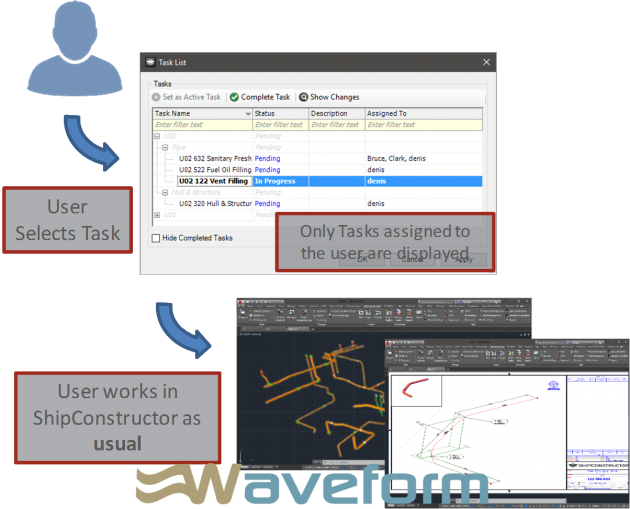
When the optional ShipConstructor project setting of “Require Tasks” is enabled, all ShipConstructor users will be required to have an active task selected before they are allowed to make any changes to the ShipConstructor project. This requirement that ShipConstructor forces users to select an active task prior to making any changes to the ShipConstructor project model is the only change the end user will experience.
The ShipConstructor end-user will only be listed the tasks that are assigned to them. Once the user selects the task, there is absolutely no other changes required by the user. They can continue using ShipConstructor exactly as they have been using it before.
With having an active Task enabled all the changes the user makes to the ShipConstructor Marine Information Model (MIM) such as creating, deleting, changes parts/drawings/spools/assemblies/nest tapes/etc. will be automatically associated to the Task.
There is no restriction on the number of people who can work on a specific task. As long as a team member is assigned to a task they can work on that task until it is complete.
Show Changes
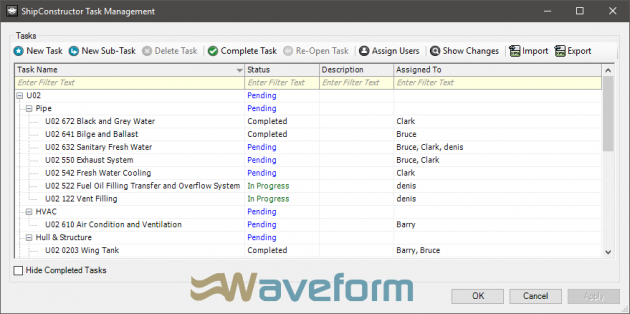
ShipConstructor Task Management can be used throughout the lifecycle of the project to view the status of each task. It will list all the tasks and their status (Pending, In Progress, Complete). This view is great to understand a high-level overview of how the project is progressing. However, it does not provide enough details if you want to know more information on a specific Task or a specific sub-Task. With the potential for multiple people working on a Task which can span weeks and have very broad changes across the project you will need to be able to get more details on the specific changes for that Task or sub-Task.
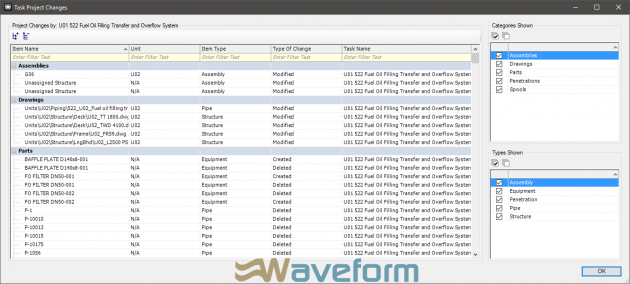
At any time during the project you can view all items that have been modified, created and deleted for any specific Task. The view separates items by categories (Parts, Drawings, Assemblies, Spools, etc.) for easier navigation. There are also additional filters you can use for a more customized view.
Communicate Changes
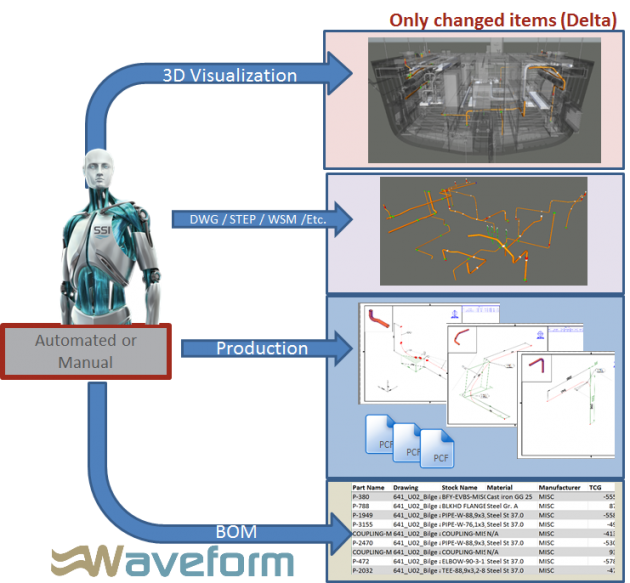
Show changes is a great feature but it is only accessible to a user who is using ShipConstructor. The reality is that there are far more people that need to see what has changed and a static list is not the best format. In today’s modern technology stack there are much better ways to communicate change than just using a list. The best way to communicate the change to each stakeholder will also depend on the stakeholder who is consuming the information. Each stakeholder will ideally want to see the information in a format that they can consume which will be different between stakeholders. For example, purchasing will want to see a BOM list of all the parts created, deleted and modified with corresponding attributes such as catalog item. The weight engineer will want a list of parts per SWBS that was created, deleted and modified with their corresponding weight information. The production floor may want to see the changes to the shop floor documents and corresponding CNC files. Other departments may want to see a 3D visual of what the parts have changed so they can quickly understand the impact of the change to their activities. These are just to name a few.
Using products in SSI’s EnterprisePlatform you will be able to automatically generate any information in many different formats to allow the end stakeholder to only get the information they need and in a context they can consume.
This automatic generation allows for formats which were not easily created before but could be significantly beneficial to communicate change. For example, with the below interactive 3D visual, almost anyone will know exactly the type of change at a high level within less than 15 seconds of navigating the model.
Go ahead and navigate the below model in your browser.
3D Visual which quickly identifies the changed items
Closing Remarks
Change Management has always been one of the main challenges the shipbuilding industry faces. The ability to communicate a change to the many stakeholders involved in the Business of Shipbuilding in a context they can consume will improve the effective communication of the change.
With modern tools, we also need to re-think the format and the content we can provide to each stakeholder. The ability to create interactive and immersive 3D visual content to better communicate change is one of many strategies other shipbuilders are leveraging.
In the next blog post I will discuss the situation when you have multiple activities such as ECO/ECN/etc. being worked on at the same time…which is always the case.
